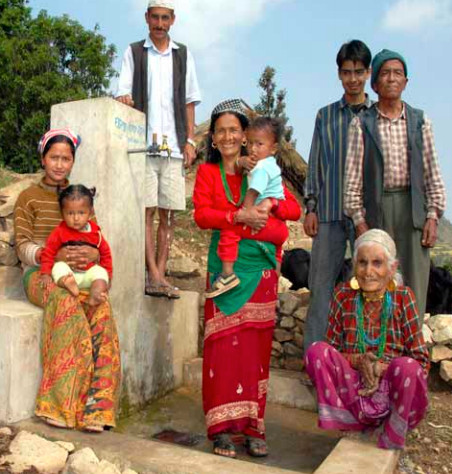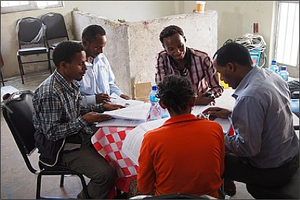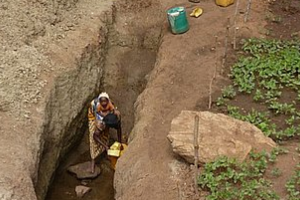3R (涵養、保有&再利用)
| |
|
|
|

ドキュメント。写真
There are three important arguments in support of 3R: 3R:を支える3つの重要な主張
1. Climate change adaptation
地球温暖化適応
Changes in rainfall may influence the livelihood of people and their economy. Water storage plays a deciding factor in the ability to adapt to climate change. Water storage is a key component in bridging momentary gaps between demand and availability of water. Many advantages are to be found in making use of the buffer function of groundwater, surface water and storage systems. These systems have the ability to offer people sufficient access to drinking water and provide water for cattle, agricultural purposes and other productive purposes. Access to water also benefits the environment and the wider ecosystem. Storage of water allows for secure levels of reserves that can be used in times of need.
降雨量の変化は、人々の暮らしや彼らの経済を影響させるかもしれません。水貯蔵は、地球温暖化を適応する能力の決定要因となります。水貯蔵は、需要および水の利用価値の間で絶え間ないギャップの橋渡しをする主な構成要素となっています。多くの利点は地下水、地表水および貯蔵システムの緩衝機能を用いることがわかっています。これらのシステムは、人々に十分な飲み水へのアクセスを提供したり、畜牛や農業目的、他の生産的な目的に関して水を供給する能力があります。飲み水へのアクセスは、また環境および幅広いエコシステムへの利益をもたらします。水貯蔵は、確保された埋蔵レベルを許可し、必要なときに利用できます。
2. Recirculation in the water chain
Water management is often limited to the paradigm of water resource allocation, availability and efficiency. It often fails to take into consideration the buffer capacity, water circulation or the re-use of buffered water. 3R can substantially contribute to increasing the quantity and quality of water resources. The use and reuse of buffered water allows for the increased availability of water, as it circumvents water allocation conflicts through simply using and re-circulating the water.
水連鎖における再循環
水管理はしばし水資源の配給量、有効性そして効率状況に限定されます。それは緩衝能力、水再循環または緩衝用水の再利用が十分考慮されていません。3Rは、水資源の量および質の向上に大幅に貢献できます。その利用および緩衝用水の再利用は、それは単純に再循環している水を使用することにより、水配給衝突を回避して、水の利用価値の増加を許可します。
3. Green water management
緑水管理
Buffering water in groundwater results in improved soil moisture and increases the availability of shallow groundwater. This way of buffering makes an important contribution to ‘green water management’. Green water management is the management of soil moisture based on improved tillage, mulching, physiochemical and biological processes. By infiltrating water into the soil, 3R contributes to green water management in a way that leaves a positive footprint on both ecosystems and agricultural production.
地下水の緩衝用水は、湿った土壌を改善させ、また浅い地下水の利用価値を増大させる成果があります。この緩衝法は、「緑水管理」に重要な貢献をもたらします。緑水管理は、湿った土壌の管理が改善された耕作地や、土寄せ、生理化学および生物学的なプロセスです。水を土壌に濾すことによって、エコシステムおよび農業生産の両方に見通しの明るい足跡を残し、見方によれば3Rは、緑水管理に貢献しています。
Contents
3R planning tool
In WASH programmes, there is a domestic water supply, sanitation and hygiene focus mainly on a household or community level and not on an area or catchment, as in Integrated Water Resource Management programmes. However, more and more linkages are made between WASH programmes and other sectors like food and energy. This requires a rethinking of WASH programmes and moving from a community approach towards a catchment approach. 3R 計画ツール WASH プログラムでは、総合水資源管理プログラムとして、世帯または地域レベルにて、地域や貯水池ではなく、国内の水供給、公衆衛生および衛生状態を重点においています。しかしながら、ますますWASHプログラムと食糧やエネルギーといった他の部門との連携がなされています。これは、WASHプログラムが再考されることを必要とし、また地域アプローチから貯水池アプローチへと動いています。
Due to increasing water demands and the negative impacts of climate change, it is crucial to effectively and efficiently store water within a catchment. The 3R (Recharge, Retention and Re-use) approach does not only enhance buffer management in a catchment for both water and food security, but also supports communities to work together in facing water scarcity and managing the resources in their catchment. However, integrating the 3R approach in local planning and implementation is still a challenge. 増大する水供給および地球温暖化の否定的な影響により、貯水池内で効果的かつ能率的に水を貯蔵することがきわめて重要です。3R (涵養、保有そして再利用) アプローチ は、 水および食糧確保の両方の貯水池での緩衝管理を強化するのみでなく、水不足に直面したり、貯水池の資源を管理したりと、地域と一緒に働きながら支えていきます。しかしながら、現地計画での3Rアプローチ計画および実施の統合は、いまだ課題となっています。
Requirements & limitations
必要条件
制限
This planning tool focuses on projects carried out by the 3R consortium in Ethiopia and Nepal. Although the aim is to develop a planning tool, which can be applied in different contexts, it will not be possible to simply apply the tool for Ethiopia and Nepal to any other country without some adaptations. The planning tool will be mainly developed for non-governmental and governmental actors working in the field of water management and spatial planning.
この計画ツールは、エチオピアおよびネパールでの3Rコンソーシアムで実行されたプロジェクトに焦点をおきます。この目的は、計画ツールを開発するものですが、異なった状況で適用でき、単純にエチオピアおよびネパールのツールをいくつのかの順応なしに、他の国に適用するのは不可能です。この計画ツールは、水管理もしくは、空間計画の分野で働いている、主に非政府もしくは政府参加者に対して開発されるでしょう。
Description & results
記載
結果
In Nepal of 2012, RAIN and Acacia Water started to develop the 3R methodology, which supports implementing organisations to integrate the 3R approach into their project planning. This method enables opportunities and challenges within an area to be included by looking at both the physical and social environment. MetaMeta and RAIN worked in 2012 on building capacity of local governments on 3R as part of the existing natural resource management framework in Ethiopia. Both projects showed that there is a strong need for 3R as a planning tool in water management projects. But knowledge, capacity and commitment are needed to actually change current planning processes of non-governmental and governmental organisations.
2012年ネパールにおいて、RAIN およびxxxは、3Rの方法論について開発を始めました、これは3Rアプローチの助けとなる団体のプロジェクト計画を統合させ、支えていきます。この方法は、自然および社会的環境の両方を見た際に含まれる地域内での機会およびチャレンジを可能にします。Xxx およびRAINは2012年に、エチオピアにおいて現存する天然資源管理枠組みの部分として3Rにおいて、地域政府の能力強化において、活動しました。プロジェクトは共に、水管理プロジェクトの計画ツールとして3Rに強いニーズがあることを示しました。しかし、知識、生産能力、および義務は、非政府および政府組織の現在の計画プロセスを実際に変更するために必要とされています。
To respond to this need, RAIN and its partners within the 3R consortium will develop a 3R planning tool and practical training modules: このニーズに応えるために、RAINおよび3Rコンソーシアム内のパートナーズは、3R計画ツールおよび実地トレーニング・モジュールを開発する予定です:
- In Nepal, RAIN is working together with Helvetas Swiss Int. Nepal to develop a similar 3R module for their WUMP planning tool,
ネパールでは、RAINがWUMP計画ツールのために3Rモジュールに似た開発をするためにHelvetas Swiss Int. Nepalと共に働いています。
- In Ethiopia, RAIN and MetaMeta are developing training modules for 3R planning and implementation.
エチオピアでは、RAINおよびMetaMetaが、3R計画および実施のためにトレーニング・モジュールを開発しています。
Catchment Assessment Tool
貯水池査定ツール RAIN, together with Practica Foundation and Wetlands International, will develop a catchment assessment tool that will support WASH projects to work with an area-driven (instead of a technology-driven) approach. Many catchment assessment tools exist, but these are often too complex for small-scale planning of RWH projects. The catchment assessment tool is based on RAINs RWH decision support tool (under development) and other existing catchment assessment tools. xxxは、xxxxおよびxxxと共に、貯水池査定ツールを開発する予定です。それは、地域主導で(技術主導の代わりに)WASH プロジェクトを支えるでしょう。多くの貯水池査定ツールが存在しますが、小規模計画のRWHプロジェクトではしばし複雑すぎます。貯水池査定ツールは、RAINs RWH決定サポートツール(現在開発中)および他の存在する貯水池査定ツールに基づいています。
Requirements & limitations
必要条件
制限
The tool can be used for small-scale catchment planning purposes focusing mainly on water scarce or water stressed areas. The tool will be mainly developed for implementers and decision makers in WASH programmes in developing countries.
このツールは、小規模貯水池計画のために特に水不足もしくは水ストレス地域に焦点をあてて、用いることができます。このツールは、発展途上国のWASHプログラムの主に開発者や意見決定者のために開発されるでしょう。
Description & results
記載
結果
The catchment assessment tool supports planning of WASH interventions at the earliest stages and takes into account opportunities and risks of the project area or catchment. It will focus on environmentally sustainable approaches and will support informed decision-making in WASH programmes.
貯水池査定ツールは、初期段階でのWASH介入の計画をサポートし、プロジェクト地域もしくは貯水池の機会や危険性を考慮にいれます。これは、環境上持続可能なアプローチであり、WASHプログラムにおいて十分な情報を得た上で意思決定ができるようにするでしょう。
RWH Decision Support Tool
RWH決定サポートツール In 2010, RAIN developed an online RWH decision support tool in a Wiki environment. The goal of this project was to develop a planning and decision tool to guide implementation, upscaling and integration of RWH into water management programmes. It consists of 14 steps, which will guide the user through the different aspects concerning water harvesting. 2010年に、RAINは、Wiki環境においてオンラインのRWH決定サポートツールを開発しました。このプロジェクトの目標は、実行を導き、 水管理プログラムへのアップグレードおよびRWHの統合し、計画および決定ツールを開発することでした。これは14ステップから構成され、水貯蔵に関する異なる見解についてユーザーを導くでしょう。
The tool links to a library containing additional information about specific aspects of water harvesting, such as water quality issues, but also provides information on good practices in water harvesting. More information can be found in the final report. このツールは、水品質問題といった水貯蔵の特定の見解に関する追加情報を盛り込んだ情報源とリンクしています。しかし、また水貯蓄における良い習慣の情報も提供しています。更なる情報については、末尾のレポートを参照してください。
Description & results
記載
結果
The tool has not been published online mainly due to the fact that it was seen as too complex (14 steps) and therefore not user-friendly. RAIN now aims to repackage the current tool into a more user-friendly tool. This tool is coming soon. このツールは、とても複雑であるという事実と(14ステップ)、使いやすくないという主な理由でオンライン上で公表されていませんでした。今、RAINは、現在のツールからより使いやすいツールへと作り直そうとしています。
3R field experiences
フィールド体験
The following projects utilize 3R using recharge, retention and reuse.
次の事業は、涵養、保有そして再利用を使用した3Rを利用しています。
 Introducing 3R in impact area of プロジェクト 影響地域における3Rの紹介 DWA |
 Scale up of Sustainable Water Access プロジェクト 持続可能な水利用のスケールアップ |
 Introducing 3R in impact areas of DWA |
プロジェクト
影響地域における3Rの紹介
Documents, videos and links
ドキュメント、ビデオおよびリンク
- 3R Smart Solutions
- PDF: WATER USE MASTER PLAN (WUMP): A concept to equitably share water resources within and amongst rural communities. HELVETAS PROJECT EXPERIENCE.
- Be Buffered: This Area is Prepared for Floods and Droughts, is Yours? 3R Water Secretariat.
- ARTICLE: Managing the Water Buffer: For Climate Change Adaptation and Food Security. By Ethiopian Institute of Water Research, Federal Institute for Geosciences and Natural Resources and MetaMeta.
- Lots of articles about reusing water for agriculture: Agropedia.
This article in other languages
他言語でのこの記事を読む
Malayalam マラヤーラム語
